Wordless Wednesday: Pictures in food April 23, 2014
Posted by mareserinitatis in food/cooking, photography.Tags: cooking, food, pictures, wordless wednesday
add a comment
Traveling off the wheaten path April 20, 2014
Posted by mareserinitatis in food/cooking.Tags: celiacs, food, gluten, gluten free diet, travel
add a comment
One thing I discovered pretty quickly is that I am incredibly sensitive to even small amounts of wheat/gluten. I am finding that this makes traveling with celiac disease a lot more challenging than I ever anticipated. It is also frustrating as one of my favorite parts of traveling used to be finding all the cool places to eat.
Unfortunately, travel seems to have become a fairly regular thing for me now, so I’m having to get used to it.
I’m learning some things that help. First, I have to either be sure there are places I can eat that are reliably gluten-free, or I have to get a hotel room with a kitchen. (I’ve become a fan of places that end in “Suites.”) I’ve also discovered that Whole Foods and Trader Joes are my favorite pairs of words when I travel (although probably Whole Foods, moreso). Planning ahead is pretty vital.
The gist of it is that a trip that involves me driving usually involves me packing a bunch of food to bring along, maybe even a cooler. If I’m flying, which was the case earlier this month, I have to have a hotel room with a kitchen and a rental car to go pick up food. I also then have to find this balance between having the right food and not overdoing it so that I don’t leave food to feed an army in the fridge when I leave.
So what do I eat?
I usually do sausage (assuming I can find a safe brand) and scrambled eggs with peppers for breakfast. Lunch involves salad with chicken (I can usually find precooked breasts or sandwich meat, although I will cook it myself in a pinch) or hardboiled eggs. For sides, I like baby carrots, and I can even make a very simplistic potato salad fairly easily. I’m finding there are a lot of packet sizes of things like coconut oil or other stuff that comes in handy as condiments. If I need something that I can’t get in packets, I just try to buy the smallest available size.
I usually find a place for dinner, but if not, there are options in the frozen foods like fish sticks or corn dogs (with more salad and carrots, of course). I’m always relieved when there’s a PF Changs nearby. We don’t have one in Fargo, so not only do I get my Chinese fix, I can do it without any gluten. And cookies…there are gluten free cookies out there.
Though it’s not the best, I also have a stash of M&Ms or something similar with me…because it’s a good idea in case schedules or something get off. (While I don’t usually get sick any more, I can’t say I feel the best if I overdo it on snack foods.)
Believe it or not, I pack a few ziploc bags, a lunch box, and a blue ice pack into my suitcase. I stuff the lunch box full of food before I leave the hotel room. I imagine I look pretty sporting hauling it around with me (it’s a soft-sided, purple and pink box), but it at least removes the temptation to eat anything that could be dangerous. And it’s better than spending half the trip sick in the hotel room…or coming back very sick.
The biggest inconvenience is the time it takes. Going to conferences can be rather tiring, and some days are very long. If I can get there a day ahead of time, I can do a bunch of shopping and prepare food, which makes it easier. I also go through and rewash all the dishes by hand before I use them, just in case someone didn’t do a thorough job and there are crumbs or other things on there. (I imagine this is a good idea, either way.)
I’m getting more practiced at this and finding that it’s not as difficult now that I’m getting better at it. I don’t even get too many comments about my lunch box any more.
3 Karrot Gluten-Free Muffins February 23, 2014
Posted by mareserinitatis in food/cooking.Tags: carrots, celiacs, cooking, fodmaps, food, gluten free diet, muffins
2 comments
(Note: I’ve made a couple changes since I originally posted this. It produces much fluffier muffins, and fluffy muffins are good in my book.)
I could tell you what I’ve been up to lately, but it’s pretty much the same thing I’ve been up to for the past year and a half: I’m either working on a paper or a proposal…although now and again I’m trying to help my student out. But really, it’s kind of getting silly to say this as it hardly changes.
I have, however, been spending a lot of time perfecting my carrot cake recipe. One day, a few weeks ago, I had this horrid craving for carrot cake. The problem I have is that a lot of gluten-free food in general tastes pretty awful: I haven’t had one I like yet. Second, even if I did like them, most mixes I come across are not FODMAPs friendly…meaning they have some ingredient or other that will make me sick. (If you’re not sure what this is, you can read about it here.) Finally, I try, as much as possible, to eat paleo. Unfortunately, FODMAPS friendly paleo foods are rather tough to come by. Most use nuts or coconut flour (or taste even worse than the run-of-the-mill gluten-free foods), so those are out.
I decided I had to come up with something myself. I added the condition that my friends who eat ‘normal’ diets must enjoy eating it, too. I am pretty sure this one succeeded. I also tried, very hard, to make it mostly carrots. I don’t think I succeeded, but I did manage to at least balance the carrot to flour ratio…it’s much better than the standard 3:1 flour to carrot ratio in most recipes. (Most carrot cake, in my opinion, is just spice cake pretending to be healthier than it is.) I am aware that most people don’t consider sugar or brown sugar to be paleo, but those, along with molasses, are the only FODMAPs-friendly sweeteners I can handle.
I’ve finally perfected my recipe, so I’ll share it below. I’m very excited because it’s one of the very few baked goods I’ve made lately that I can actually eat myself. I will warn you that it’s really a pain to make, but it’s totally worth it. However, I’m quite serious when I say not to deviate from the instructions. As much as I love kitchen short-cuts, you don’t want to just throw everything in the food processor and call it good.
And one last note: while you may want to try substitutions, be very careful about maintaining the moisture balance in these muffins. I learned the hard way (and repeatedly) that one little change can leave you with hockey pucks or mushy gunk in short order. Therefore, this recipe won’t work if you decide to throw honey in for the brown sugar. You CAN get away with 1/4 c. of a dry sweetener instead, like palm sugar or raw cane sugar, if you want to try something else.
If you do make changes, please let me know so that I can pass them on to anyone else who is interested.
3 Karrot Muffins
Makes about 12 muffins.
Ingredients
- 11-12 oz. fresh raw peeled carrots
- 2/3 c. dehydrated carrot (make sure it’s not processed on the same equipment as wheat…I buy them online)
- 3 eggs
- 1/3 c. potato starch
- 1/3 c. tapioca flour
- 1/3 c. sweet rice flour
- 1/4 c. white rice flour
- 1/4-1/3 c. brown sugar
- 1 tsp. baking powder
- 1 tsp. baking soda
- 2 tsp. cinnamon
- 1 tsp. nutmeg
- 1/2 tsp. ginger
- 1/4 tsp. salt
- 1/3 c. coconut oil
- 1 tsp vanilla extract
- 1 tbsp lemon juice
Optional cream cheese ‘filling’
- 4 oz. cream cheese, softened
- 2 tsp. coconut oil
- 2 tsp. sweetener (sugar, maple syrup, whatever)
I’m going to start with the cream cheese filling: you don’t have to do it. If you’d like to do it, there’s an easy way and a harder way. The easy way is just to cut your 4 oz of cream cheese into 12 chunks of the same size. It tends to dry and crack a bit though, so the harder way is to blend the cream cheese and coconut oil (and sweetener, if you want some) in a small bowl using a mixer. This will have a nicer texture and look nicer, but it doesn’t really taste much different. Put it in the fridge for later.
Preheat the oven to 350ºF.
Mix the eggs and dried carrots in a separate bowl. Set aside. Leave this sitting for a while. In essence, you’re using your eggs to rehydrate the dried ones.
While waiting for the carrots to rehydrate, add the following dry ingredients in a large mixing bowl: potato starch, tapioca flour, sweet rice flour, white rice flour, brown sugar, baking powder and soda, cinnamon, nutmeg, ginger, and salt. Combine thoroughly.
Place the raw carrots in a food processor or blender (if it’s a really good blender) and run until the carrots are finely chopped. (By finely chopped, I mean ‘not quite a puree but as close as the machine can get.’) Next add the dried carrots and egg mixture. The eggs should whip up and give the mixture a lighter orange color, and it should look like a puree. (Note: don’t shortcut and throw it all in the food processor at once unless your machine is VERY good. I tried that and ended up with a serving of baked carrots in the middle of a couple of muffins.)
Before you take the next step, get your muffin pan ready. I generally like to use foil muffin papers for these as they seem to soak through paper liners. I also suspect the foil liners do a better job of baking the muffins evenly.
Add the coconut oil, vanilla extract, and lemon juice to the food processor and run again. Add contents of the food processor to the bowl of dry ingredients and combine thoroughly. I usually just use a large spoon to do this as the mixture seems awfully thick for a mixer. Divide batter evenly between muffin liners.
If you’re using the cream cheese (mixture), add about 2 tsp. to each muffin. Make sure to press it down into the batter a bit. I don’t recommend making divots in the muffins as it seems to create big air bubbles.
Bake for 25 min. Let cool for a couple hours at room temp before serving (even though they smell incredible). Because of the raw carrots, these put off a lot of moisture and need to be cooled properly.
Recipe Double Header: Maple-whipped sweet potatoes and gluten-free sweet potato pancakes January 1, 2014
Posted by mareserinitatis in food/cooking.Tags: breakfast, celiacs, cooking, food, gluten free diet, paleo, pancakes, recipe, sweet potatoes
add a comment
The other day, Mike and I were eating at one of our favorite local restaurants (i.e., one of maybe five that is celiac-friendly and hasn’t tried to kill me yet), I tried a new dish: maple-whipped sweet potatoes. We both fell in love with it, and so I’ve made it a couple times at home. It’s super easy. Also…it might be paleo, depending on your feelings on maple syrup.
The best part of making these is that I usually make large enough quantities that there are leftovers. Some people I know think, “Yay! Leftovers!” I personally think, “Yay! Pancakes!” Some people think that’s too much work. However, given I cringe every time I watch my kids dump a half gallon of maple syrup on pancakes, these are sweet enough (in my opinion) to avoid syrup altogether…unless you’re younger son who still thinks they need syrup. A pat of butter is nice, though. So far, everyone in the house seems to like them.
Maple-whipped sweet potatoes
2 lbs. of sweet potatoes, peeled and diced
1/2 tsp. cinnamon
1/2 tsp. nutmeg
3 tbsp. coconut oil
1/4 cup. maple syrup OR 1/4 cup brown sugar, 2 tbsp water, 2 tsp maple extract
Toss the sweet potatoes in the cinnamon, nutmeg, and coconut oil. There’s two ways you can do this, depending on the time you have. You can throw them in the crockpot (low for 5 hrs, high for 3 hrs) or bake in a covered dish at 350°F for one hour. I prefer the crockpot method as they always seem more moist, but if you’re in a hurry, you’ve got options. Once they’re done cooking, let cool for 5-10 minutes, then put them in a large mixing bowl with the maple syrup. Use a hand mixer and blend until smooth and creamy. (Whether you’re doing this with the brown sugar mixture or maple syrup, you may need to add water, a tablespoon at a time, to get it creamy.)
Serves 8.
Sweet potato pancakes
1 lb. maple whipped sweet potatoes
1/4 cup tapioca flour
1/4 cup potato starch
1 tbsp. coconut oil
1 egg
Mix all ingredients together and cook on a non-stick pan or griddle on medium-low to medium heat until browned. Flip, and brown on the other sides. I’d suggest making smaller pancakes – about 3 inch diameter. You have to watch these carefully. Because of the high sugar content, they go from brown to blackened very quickly if the heat is too high. Also, there’s no good way to see if they’re done on one side except for checking. The high moisture content insulates the top side when the bottom side is being cooked.
Serves 4.
Post Christmas food frenzy: buckwheat crepes December 28, 2013
Posted by mareserinitatis in food/cooking.Tags: celiacs, cooking, food, gluten free diet, recipe
2 comments
Our family has had a tradition of having a ‘nice’ breakfast or brunch on Sunday mornings. For a while, this consisted of getting together with extended family and calling it “waffle Sunday” because we almost always had waffles. (After my celiac diagnosis, the waffle maker was handed off to another home where it is hopefully happy.) Later, I spent the summer with a friend in Berkeley, and the topic of crepes came up.
I adore crepes.
My friend said his grandfather made the best crepes ever, and so he spent a morning teaching me how to make them. It was far simpler than I thought. You combine 1 cup of wheat flour, 1 egg, and enough milk to have a very sloshy liquid. It’s probably the same consistency as warm custard before it’s set, or maybe egg nog. Then you add about 1/2 tsp. of some sort of oil to a small frying pan, and once it’s hot, add enough batter that you can spread a thin layer over the bottom of the pan. Cook until the edges start to get crispy, then flip. I moved from white flour to whole wheat flour (and my tummy hurts just saying that) because I liked the nuttier taste.
It’s not easy to make gluten free crepes. But another thing I adore is buckwheat because of it’s nuttier taste. The search was on, and I came across a wonderful site explaining the history of crepes and galletes. Unfortunately, it wasn’t quite what I was looking for as I wanted a buckwheat crepe that would be suitable for things like fruit fillings, and apparently galletes are not. I was thrilled when I came across this recipe for a way to improve the nutritional value of buckwheat and make a sort of pancake out of it. Still…too thick.
I decided instead to try my old recipe using the principles of soaking the buckwheat groats first. I took 2 1/2 cups of groats and soaked them in water for several hours. (You’ll want to check the recipe link to see why I do this.) I then rinsed the groats and blended them with a mixture of water and heavy cream (2:1 ratio, respectively). Once I had a thick enough batter, I added about 3 eggs. Then I continued to add water and cream until I had the same egg-nog consistency thickness I got with my wheat-based crepes. Everything else went the same as before, using between 1 tsp. to 1/2 tbsp. of coconut oil to cook the crepe. They will work for either savory or sweet fillings, if you like a nutty flavor. They are very filling, either way.
Gluten-free buckwheat crepes
(serves 2-3)
1 cup buckwheat raw buckwheat groats
1 egg
1 to 1 1/2 cups water and heavy cream mixed 2:1 (or milk of your choice)
coconut oil
Pour buckwheat into a bowl and add dechlorinated water to about 1 inch above buckwheat. Let soak for several hours. Strain and rinse with warm water to get rid of slimy texture. Add groats, egg, and water/cream mixture to blender and blend to smooth. Continue to add water/cream until batter is ‘soupy’.
Add coconut oil to non-stick frying pan over medium to medium high heat (somewhere between 1 tsp. and 1/2 tbsp per crepe). Add about 1/3 cup batter, pouring into oil, and tilting pan to coat the bottom. (You will have to figure out how much works for you depending on how large your pan is and how thick you like your crepes.) Cook until brown spots form on underside of crepe. Flip crepe and cook for an additional 30 seconds.
Favorite toppings at our house are sliced bananas, berries, sometimes whipped cream. We’ve also used straight syrup (did your insulin level just go out the roof), philly cream cheese honey and nut spread, or a blend of cream cheese (4 oz), orange marmalade (1 tbsp), and maple syrup (1 tbsp). If you want to go the savory route, ham and cheese are always good choices.
The paleo diet: just like grandma used to make October 19, 2013
Posted by mareserinitatis in food/cooking.Tags: celiacs, cooking, food, gluten free diet
2 comments
I know this isn’t really sciencey in the physics sense, but it’s been an interesting exploration for me. In the past couple of months, I have been doing some dietary changes, primarily because I’m finding that, with my celiac disease, I really can’t tolerate any grains except rice. Even the wonderful, delicious, gluten-free Udi’s bread and muffins obviously do a number on me and have to go.
As a result of trying to go grain-free, I’ve started reading a lot about the paleo and primal diets. It turns out I’d pretty much gotten rid of dairy (although I have another post about that particular adventure) and beans since those have made me sick for a long time.
When you read the comments about paleo by non-paleo folks, it’s interesting how they discuss it as an extreme diet, how it’s horribly based on animal foods, etc. I understand what they mean. I have always had a bit of trouble with the idea of eating organ meats, which are touted as wonder foods. I remember being force-fed liver as a kid and forced to cook it as a teenager. I watched in disgust as my parents and grand-parents would squabble over turkey hearts and gizzards at Thanksgiving. (Heck, my dad and grandmother still argue about it.) Who would eat that stuff?!
Thinking about these things brought me back to a lot of the dreaded trips to relatives as a kid. Beyond the organ meats, there were canned veggies. My grandmother canned everything, and with the exception of peaches, it was generally pretty gross once it came out of the jar. That’s what they did on the farms: grow as much as they could during the summer and then can it for the winter. Old habits die hard when you grow up on a farm, so that’s what we ate for dinner at grandma’s: lots of canned veggies.
I often wondered about how these old ladies could live well into their nineties eating some of this stuff. It could only be attributable to their sturdy constitutions, as far as I was concerned. They had those hardy German-Russian and Norwegian genes to keep them going.
Except now I’m sitting here in my 30s with an autoimmune disorder that’s becoming increasingly common and I’m starting to wonder…if I ate that awful stuff, could I live into my 90s? Because really, I look at this “extreme paleo diet” and am realizing that it’s really not that different than the things that farm families ate all the time in the rural areas of North Dakota just 100 years ago.
I pulled out my copy of “German Food and Folkways” and started looking very carefully at the recipes. You know what I noticed was lacking? Flour. There are a few recipes here and there, but they’re scattered and there’s no section that focuses on baked goods.
I did find a huge section talking about meats. Apparently my German-Russian ancestors probably gorged on liver and kidney. They ate tons of fresh eggs and raw or fermented dairy. And then there were the veggies: copious amounts of beets, cabbage, and potatoes.
Corn was fed to animals when there wasn’t much to graze, so no one in their right mind would eat it. Wheat flour was used occasionally but not all the time because it was a lot of work to process and would go bad pretty quickly, not to mention attract rodents and other pests.
Now I’m starting to wonder. Rather than telling people that I’m going on the paleo diet, which people think is extreme, I wonder if they would react better to me calling it the traditional German homesteader diet? Because bacon is involved, I’m sure they’ll be more open to it.
And now you’ll have to excuse me…I have to see if I can force myself to cook some liver and onions.
Friday Fun: Your father smelt of elderberries! August 16, 2013
Posted by mareserinitatis in food/cooking, photography, younger son.Tags: berries, food, hiking, outdoors, pictures
4 comments
During the past week, we took a family vacation before school started. We chose to spend a few days at Lake Itasca State Park in Minnesota, which is the home of the Mississippi headwaters. There are tons of places to go hiking, so we chose a trail and found, much to our delight, that there were tons of wild raspberries growing along the trail. We picked them as we walked, and by the time we were done with our hike, we were almost full.
This little adventure left me and the younger son really curious about the other berries on our outdoor excursions. We took some pictures and then went and bought a berry guide at the visitor center.
The following is a visual guide of most of the berries we saw and our best guesses as to what they were:
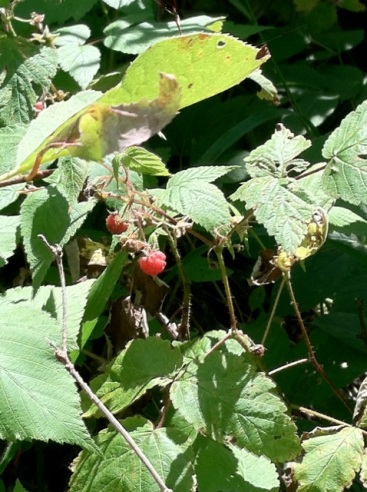
These, of course, are wild raspberries. They are called an ‘aggregate’ berry and all the little spherules are called ‘drupelets’. It turns out that pretty much every aggregate berry is safe to consume. The only exception to this I’ve come across is goldenseal, which has pointy drupelets. Don’t eat it them if they’re pointy, I guess.

These cuties are bunchberries. They are apparently edible but don’t taste very good. (We didn’t eat any of these.) You have to be careful, though, because baneberries can resemble these, so you have to pay attention to the leaves. Bunchberry leaves grow in whorls. (See the next berries, and you’ll understand what I mean.)

This is white baneberry, also called dolls’ eyes. It’s apparently pretty bad for you (as are pretty much any other white berry, with one exception). So if you get lost and need food, stay away from the white berries. Also, these can come in red, so you have to make sure you don’t confuse them with bunchberries (above). Baneberries have a jagged compound leaf structure whereas bunchberries are smooth whorls of 4 or 6 leaves.

I never did figure out what this is, but my guide says to stay away from anything green and spiky unless you know it’s a gooseberry…and this is obviously not.

These are elderberries, and they aren’t edible. I found with the berries in bushes/trees that you need to look at the leaves. These have compound leaves that are opposite each other. However, these are also super tiny, so that is another give-away.
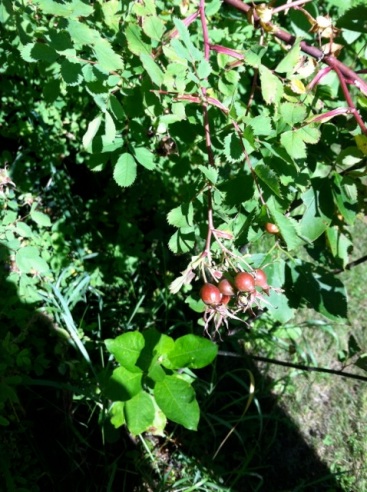
These are rosehips. They’re rather large and, well, on a rosebush. They are edible but apparently aren’t always that tasty so we opted not to taste-test these. Rose hips also have the dried sepals at the end of the berry, so that makes them easy to identify. This is another good one to look for if you’re lost in the woods as nothing toxic looks like it. Also good to look for if you’re lacking citrus as they have a lot of vitamin C.
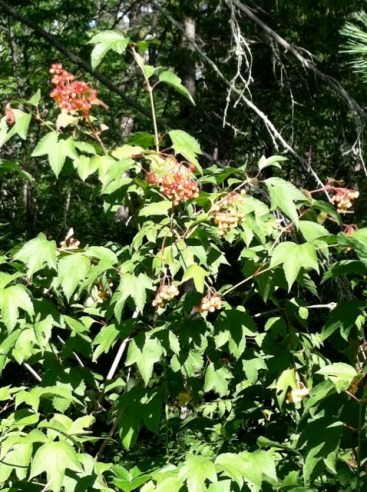
It took us a while to figure these out, but we finally decided on high-bush cranberries. They were too far away to give them a try, but we found that they apparently resemble a lot of other berries. The give-away on this was the leaves: they look like 3-lobed maple leaves. Upon realizing this, we had narrowed it down to either high-bush cranberry or currants. The difference is that these are opaque and have a slightly different berry structure than currants, which are translucent when ripe.
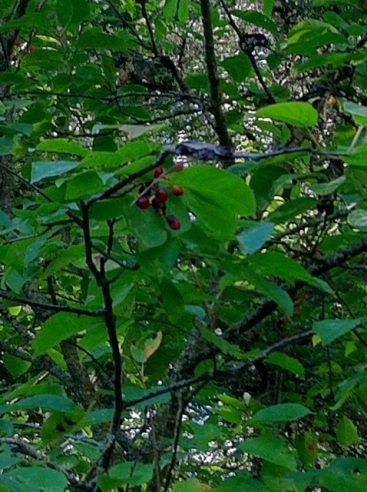
This was our other big find from the trip: ripe common chokecherries. The leaves are similar in shape to elderberries, but they alternate instead of being opposite each other. When ripe, they taste an awful lot like regular cherries except for a sort of dry taste. They also have a large pit (and I guess you don’t want to swallow the pits as they contain cyanide). A lot of berries that are toxic will cause tingling or numbness, and the younger son, upon trying one, freaked out because he had confused the dry taste of the berries with tingling. However, they were really sweet. And in case you were wondering, the younger son survived the ordeal.
And the main reason this is fun is because I now understand the second half of this joke better.
(Elderberries apparently don’t smell very good…)
Repost: Microwave Unsafe or Unsafe Microwave June 22, 2012
Posted by mareserinitatis in electromagnetics, engineering, food/cooking, science.Tags: cooking, engineering, food, microwaves
add a comment
(Note: this is from the old blog, back when living in Minneapolis)
There’s nothing like a nice, hot cup of English Breakfast or Earl Grey in the morning…until you reach into the microwave and burn your hand on your mug.
I’ve noticed something very irritating. Since I moved into my new place, all of my dishes get hot and some of them have cracking glaze after use in the microwave. The most irritating thing, aside from the pain, is that I’ve noticed my favorite mug is expanding and shrinking. It expands when heated and then contracts as it cools. This, unfortunately, has caused my tea basket to get physically stuck in the mug, which never happened with my old microwave (thus eliminating the notion that heating of the basket causes it to expand and get stuck).
Traditionally, this means that my dishes are not “microwave safe”. In other words, there is something in the dishes that heats up when put in the microwave. That means that you can destroy the dishes and burn yourself.
It wouldn’t be that big an issue except that all of these dishes worked fine in my other microwave back in Fargo.
This has led me to look into what might be causing the problem. Hypothetically, if something is microwave safe in one microwave, it should be that way in all microwaves.
Hypothetically…
There are lots of places that give you the basics of how a microwave works. A brief overview is that it emits electromagnetic waves which cause water molecules in food to rotate. The frequency of most commercial microwaves for the home is around 2.45 GHz, which is apparently a good frequency to get water molecules to “flip”. Flipping, rotating, shaking are all ways that molecules move, and molecular movement translates into heat. So the microwave makes all these water molecules do their jig because it excites them at just the right tempo. If you try exciting them at a different frequency or tempo, the water molecules won’t respond as well.
It’s harder to find information about how microwaves create these fields. It turns out that they generate electromagnetic waves with something called a magnetron. (An excellent and quite detailed description of how they work can be found here. According to The Art of Electronics, magnetrons fall under the category of “exotic devices”. This is probably code for “uses an electromagnetic field in a non-obvious way” or maybe “doesn’t always use silicon to do its job”. Interestingly enough, these are the same devices used to create fields for radar, including the Doppler radar that is used to look at cloud cover and precipitation. (If you’re a Wunderground nerd, like me, you spend a lot of time looking at images generated by Doppler radar.)
Again, I’ll summarize. There is a cathode (something which generates electrons) running down the middle of a cylindrical chamber. The chamber is subdivided into resonant chambers. Resonant chambers are areas where electromagnetic energy creates a standing wave. (A good though not exact analogy from sound, which is also a wave, would be an organ pipe.) The electrons formed around the cathode form into groups which spin and sweep past the resonant chamber openings. Because moving charge creates an electromagnetic wave which becomes a standing wave in the resonant chambers. This wave then creates a current in a wire or “feed”, which conducts a current to a waveguide. A waveguide is basically a replacement for a wire. It conducts an electromagnetic field when the power is too high or you could easily lose too much power through a wire. (Wires can be awfully lossy.) All it looks like is a rectangular tube, but the size of the tube is important because this will determine the frequency of the waves it can carry. (Remember, we want to have things pretty sharply focused at 2.45 GHz.) This tube leads into the microwave chamber which is tada! a Faraday cage. This is something that will contain electromagnetic energy inside of it without letting it escape as well as keep electromagnetic energy from your surroundings out. In this case, we want the energy inside. Waves which don’t hit our food will hit the side of the chamber and bounce around until it hits the food.
That metal screen is part of the Faraday cage and is keeping your brains from being baked when you’re pressing your nose to the glass going, “When will it be done?!”
Many microwaves contain things that look like fans but are actually “mixers” or “stirrers”. They cause the waves to bounce more randomly and create a more even distribution of the waves for heating. When the waves hit your food, they can only penetrate to about an inch. How far the wave goes into the food is quantified by something called a “skin depth”. Because your food isn’t a good conductor (like copper) which has pretty much no penetration depth, you will often notice that things get hot on the outside but not on the inside, like often happens to me when I reheat lasagna.
Food is also not a pure dielectric (like air or styrofoam) where the wave passes through and can’t generate a current inside. Food which is more conductive (which will likely have more water) will tend to heat up better or faster (as well as internally distribute that heat better) than food that doesn’t. Conductive food will also tend to have more water. In this case, you may be heating up a fruit-filled pie. The pie filling has a lot of water and will heat up fast, but the crust doesn’t and doesn’t seem to get as warm. You bite in, expecting the filling to be the same temp as the crust but end up getting burned instead.
People who design fast food meals ought to consult with microwave engineers on optimal heating set up. :-)
As I mentioned before, microwave safe dishes don’t contain anything that will heat up when exposed to microwaves. Dishes which aren’t microwave safe contain some molecules that will be able to rotate, twist or vibrate in some way similar to water, causing the dish to heat up.
Sometimes you have dishes which are “thermally conductive”…that is, they transfer heat well. While you’re heating up your food, the dish is pulling a lot of that heat away from the food and into itself, causing the dish to get hot.
However, that doesn’t seem to be my situation. My previous microwave was much a higher power and seemed to heat up the food fine without heating up the dishes. My current one seems to do nearly the opposite. And since these are the same dishes, I have to conclude that it is in fact the microwave with the issue.
My first guess is one that doesn’t seem plausible. I don’t think it has anything to do with the size/shape of the magnetron or waveguide. Those are fairly large objects that can be mass constructed well within tolerances. I could be wrong, but that’s my initial guess. This also minimizes the chance that there may be some sort of mismatch between the magnetron and the waveguide.
Looking at the remaining possibilities, I’ve come up with three.
The first is that my microwave is poorly designed in the sense that it doesn’t direct electromagnetic energy well. This may be part of the problem as it seems to heat the dishes in areas away from the food. I don’t think that this is the entire issue because, if designed poorly, the wave should just bounce around until it hits something with high water content. However, I can’t say it’s not doing this.
There are two other possibilities. It turns out that magnetron frequency can change both with the temperature and the current through the cathode. Although the cathode temperatures get pretty high, I doubt that it would be that huge a change from a prototype once it gets over the initial change.
The last option seems most likely to me: the cathode isn’t working exactly the way it’s supposed to (which can be characterized by something called a “pushing curve”). If the current from the cathode is too high or too low, this will change the way the electrons behave, which will alter the frequency of the wave being generated by the magnetron.
In doing some research on my microwave, it turns out to have a horrid reputation. They die a lot, like within a year. Unfortunately, they’re so cheap that it’s not worth it to send them in for repairs because you have to pay for shipping to and from. When microwaves die like this, a lot of times it can be due to power problems, and thus the design of the controlling electronics or the high voltage power system can come into play. (Did I mention that magnetrons require huge voltages to operate???)
It appears that perhaps this line of microwaves may not have the best electronics design, and for whatever reason, the power into the magnetron isn’t quite right. This is causing my dishes to heat and expand while not heating my food optimally.
I guess I’ll be using oven mitts to take everything out of there until it decides to kick the bucket.
A Note to Parents: Healthy Food February 15, 2012
Posted by mareserinitatis in food/cooking, older son, societal commentary.Tags: food, hypoglycemia, older son, younger son
1 comment so far
I have a major irritation that flaired up today: parents who feed junk food to their kids…or, more importantly, my kids.
Yes, I do realize it’s Valentine’s Day and that such an occasion requires force feeding large amounts of sugar-laden artificially produced stuff to small people, as was the custom when I was in school. However, some of the parents went overboard at younger boy’s school and provided a chocolate fountain. I also realize they brought healthy stuff to dip in it (like strawberries and bananas)…but I don’t understand why they didn’t just bring the strawberries and bananas while leaving out the chocolate fountain.
Before you accuse me of being heartless (ha!) Scrooge, I am not some health nut who only feeds her kids macrobiotic foods (although I do see the wisdom in that). My problem with this is that my kids are hypoglycemic, and I’ve suffered for years with parents bringing cookies and crap like that for snacks at school.
For the older boy, his hypoglycemia results in very angry outbursts. Some of these outbursts got him sent to the principal. The younger boy, however, will be bouncing off the walls and unable to focus. If we hadn’t determined the food connection, I’d swear up and down that he’s got some sort of ADHD that comes and goes.
On the other hand, I don’t think it’s just my kid. I’ve had teachers discuss with me how a LOT of kids seem to get unfocused after having particularly high levels of sugar.
That being said, if you are a parent, please think about these things when bringing snacks. Good foods would include things like crackers and bread, cheese sticks, nuts (if no one has nut allergies), whole fruit, beef jerky, celery and carrot sticks.
Things to avoid: yogurt pops (they are LOADED with sugar); most granola bars – also loaded with sugar, although the Kashi brands aren’t too bad; fruit juice…you may as well being giving them kool aid; cookies and cake are just plain out.
We’ve made an agreement with the younger boy’s teacher that he has cheese and crackers in his backpack. If the snack tastes sweet, he’s supposed to have his cheese and crackers along with the snack to prevent a huge blood-sugar spike and crash. Prior to this agreement, my son would be coming home from school half the time, unable to concentrate on any thing aside from a video game.
I realize most people’s kids aren’t as sensitive, but it makes sense to me that you’d want to avoid unnecessary sugar anyway. However, that doesn’t seem to be the case, and it’s amazingly frustrating to deal with on nearly a daily basis. So please – before you buy the frosting-covered cookies from the bakery, see if there isn’t something even marginally less sugary. My kids and I thank you.
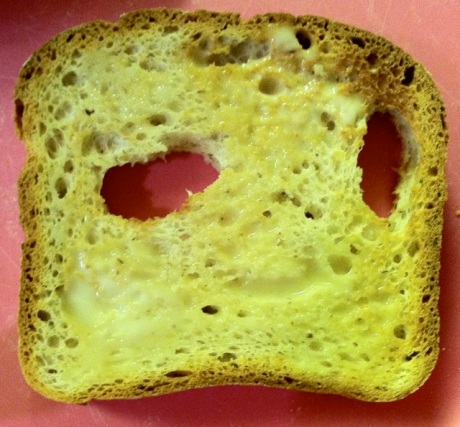


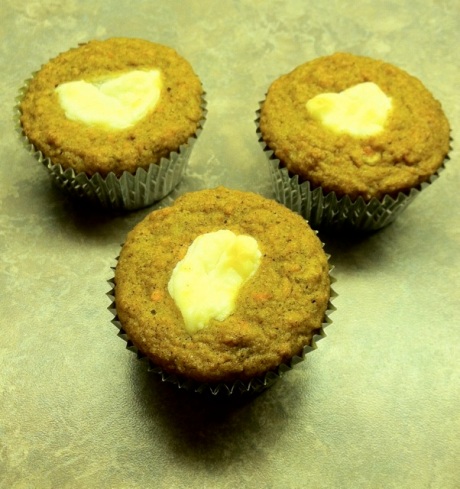

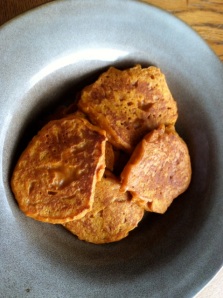


 I also blog at Engineer Blogs, home away from home to some of the best engineering blogs.
I also blog at Engineer Blogs, home away from home to some of the best engineering blogs.
The difference a diagnosis makes August 6, 2013
Posted by mareserinitatis in food/cooking, societal commentary.Tags: celiacs, cooking, food, gluten, gluten free diet, health, low-carb
12 comments
I’m almost upon the 1 year anniversary of receiving my official diagnosis of celiac’s. It’s a happy thing for me because I’m feeling and looking far better than I did a year ago despite the fact that I still have a ways to go. I’m still waiting for my ability to digest peaches to be restored.
To celebrate, the FDA has just released new regulations stating that gluten-free items must have under 20 ppm of gluten. (Coincidence…but they were supposed to have come out with a decision on this
monthsyears ago.) My friend Kari posted an article about this on FB:It was an interesting article, but their whole ‘gluten-free is just a fad’ undertone got on my nerves. I’ve seen a lot of articles like this (I discussed one at length in this post).
This sort of thing gets on my nerves because for years I had to listen to people tell me how my low-carb diet was a fad and not healthy for me. I went on a low-carb diet at the age of 22 because I had fibromyalgia (*ahem* not really, but I didn’t know that then) and having weight problems. Miraculously, I got better after going on the diet. (Not so miraculous now that I know what I have.) However, the fact that I felt better and lost weight didn’t phase people. I continually heard from doctors how I was going to end up with high cholesterol, how the weight I’d lost was ‘water weight’ (ummm…I’m sure that 80 lbs. was all water), and on and on. I was flummoxed: I was told I needed to lose weight but once I did, I was lectured on how I did it the wrong way. As a side note, the fact that I was no longer in pain and my fatigue had gone away were irrelevant.
Going to any social gathering was even worse. I would be rather careful about what food I ate (and I never felt I was overly picky…just asked them to please hold the bun or whatever), but it never mattered. Inevitably, some stranger would come up and begin lecturing me on my poor food choices. I came to the conclusion that there were really a lot of busy-bodies out there who had nothing better to do than search out people who really weren’t looking for any advice on their diet in order to fill their ear.
I’ve been putting up with this for 15 years. I can no longer count how many times I’ve had to justify to ‘strange’ dietary choices to people. And the funny thing is, they never want to hear how as a vegetarian/vegan or on a normal diet, I actually grew sicker. (Celiacs, it turns out, impairs the body’s ability to digest protein.) The implication was that I must not have been doing it ‘right’…whatever that means. The fact that, in the last few years, it wasn’t working was an additional reason for people to come out of the woodwork and criticize my choices…nevermind that what they were telling me was exactly the wrong thing to do.
Now that I have the magical diagnosis, it’s amazing how differently people react. I always bring my own food with me to social things. If someone asks, I just say I have celiacs. Rather than telling me how unhealthy my diet is, I most often get the observation that I am eating very healthy. No one grills me about why I eat the way I do or tells me that I’m making poor choices anymore, but they ask questions about how I handle it and what things I need to look out for. Occasionally, I will get comments about how they know someone who has celiacs, as well. In fact, in the past year, I have had ONE negative comment about how gluten-free diets were a fad…and that person was obviously so woefully uninformed about that (and several other topics) that I didn’t bother wasting too much brainpower on him.
This has me stunned. The reason why I’m stunned is because I’ve hardly changed my diet at all. It was very easy to transition to gluten-free because all I really needed to do was cut out a slice of bread or a dessert here and there. (Okay, so I did have to cut out my favorite Chinese restaurant permanently, and I do have to buy all gluten free soy sauce, which is a bit of a pain.) Most of my diet was already protein and vegetables, and I’ve really found that sticking with that has been pretty easy as I’d already been doing it for 15 years. The only major difference I’ve noticed is in people’s perceptions.
This is why I get frustrated when I see these judgmental articles about how people who are doing things ‘gluten-free’ or ‘low-carb’ are just following a fad. I don’t suppose it’s ever occurred to the writers of such articles that food can have a profound impact on how your body feels and that, just maybe, some people really are paying attention to that. People don’t like to be sick or fat or tired all the time, so if they say something is helping them to feel better (particularly when 40% of people with celiacs have no symptoms), then I’ll cheer them on for making healthier choices.